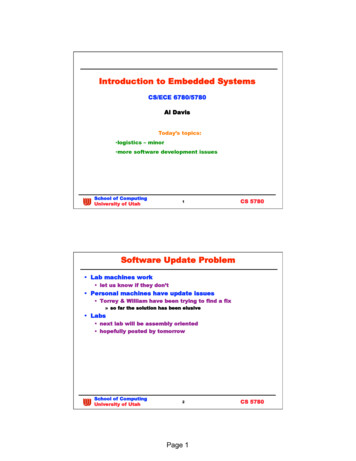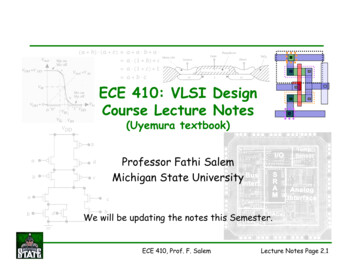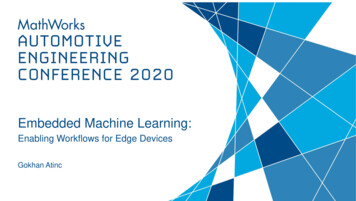
Transcription
CS/ECE 5780/6780: Embedded SystemDesignJohn RegehrLecture 1: Introduction to Embedded Systems
Embedded systems: definitionIAn embedded system is:IIIa special-purpose computer designed to perform dedicatedfunctions often with real-time constraints.a system embedded as part of a complete system.really any system that is not a PC.although PCs containseveral embedded systems.
Embedded systems: functionIFive main categories:IIIIIIDigital signal processingControlNetworkingUser interfacingData storageMost embedded systems perform more than one of thesefunctions.
Popularity with consumersII 99% of new microprocessors are found in embedded systems.Cnet’s Top 10 Must-havesIIIIIIIIIIApple iPhoneApple iPod NanoVuduNintendo WiiApple MacBookSling Media Slingbox A/VSony PSPSamsung LN-T4665FSony Handycam HDR-CX7Shure SE110 Sound Isolating Earphones
Popularity with other -sale systemsRoboticsMedicalIIISatellite phonesCell phone base stationsIndustrialIIAir bag controllersAnti-lock brakesLife-supportMedical testingMilitaryIIGPSMissile guidance
Embedded systems designIWhy is it unique?IIIIIComputation is subject to physical constraints such as timingdeadlines, memory restrictions, and power consumptionrequirements.The traditional abstraction of separating software from thehardware and environment does not work.Hardware, software, and control are integrally intertwined.Designers must understand both hardware, software, andcontrol.”The Embedded Systems Design Challenge” by Henzingerand Sifakis continues this discussion.
Top-Down Design Process
Analysis PhaseIIIIDiscover the requirements and constraints.Requirements are general parameters that the system mustsatisfy.Specifications are detailed, specific requirements.Constraints are limitations under which the system mustoperate.
Embedded system design metricsIIIIIIIIIIINonrecurring engineering costUnit costSize & weightPerformance (accuracy, precision, resolution, response time,bandwidth)PowerFlexibility, maintainability, reliability, testability, ctnessSafetyLook & feel
High-Level Design PhaseIIIIBuild a conceptual model of the hardware and softwaresystem.Design broken into modules or subcomponents.Estimate cost, schedule, and expected performance.Develop a data flow graph for the system.
Data Flow Graph for a Motor Controller
Engineering Design PhaseIIIIConstruct a preliminary design.This should include the hierarchical structure, basic I/Osignals, shared data structures, and overall software scheme.Build mock-ups of mechanical parts and user softwareinterface.Call graphs can be used to show how software and hardwareinteract.
Call Graph for a Motor Controller
Implementation PhaseIIIIDuring this phase, the design is actually built.Implementation of subcomponents may actually be startedduring the earlier phases.Debugging embedded systems can be very difficult.Therefore, extensive use of hardware/software simulation andcosimulation is essential.
Testing PhaseIIIDuring this phase, we evaluate the performance.First, debug and validate the basic functions of the system.Next, evaluate and optimize various performance parameterssuch as execution speed, accuracy, and stability.
Maintenance PhaseIDuring this phase, we:IIIIIIICorrect mistakes,Add new features,Optimize execution speed or program size,Port to new computers or operating systems, andReconfigure the system to solve a similar problem.Must be able to deal with changes in requirements orconstraints.Not actually another phase, but more loops through the entirecycle.
Bottom-Up Design Process
Basic Components of a Computer System
Memory-Mapped Computer System
Isolated I/O Computer System
Memory Read Cycle
DMA Read Cycle
CS/ECE 5780/6780: Embedded System Design John Regehr Lecture 1: Introduction to Embedded Systems. Embedded systems: definition I An embedded system is: I a special-purpose computer designed to perform dedicated functions often with real-time constraints. I a system embedde










